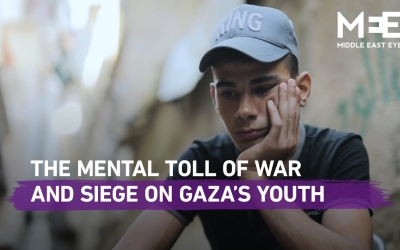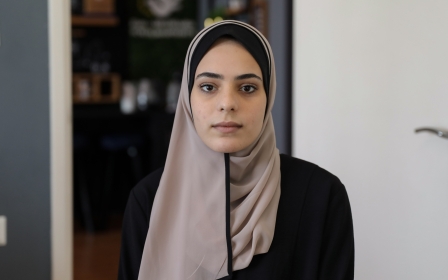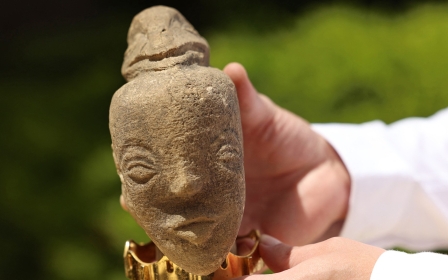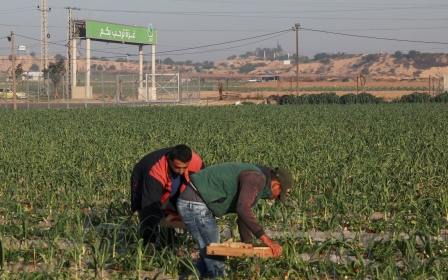Children of Gaza left traumatised a year after Israeli bombardment
Every night 11-year-old Nadine Abdullatif says she prays the ceiling of her bedroom won't fall on her as she sleeps.
She appeared in a video that went viral during Israel's attack on the Gaza Strip in May 2021, where she broke down while talking to Middle East Eye after Israeli air strikes flattened her neighbours' house, killing eight children and two women.
In the video, which has been viewed millions of times, Abdullatif appears tearful and devastated as she stands near her neighbours' home.
Gesturing at the rubble behind her, she asks: "You see all of this? What do you expect me to do? Fix it? I'm only 10."
Speaking to MEE again on the first anniversary of the attack, she said her worst nightmare would be to witness that scene again.
"I'm terrified that another offensive would be launched on Gaza and something bad like this happens to my family or neighbours," she said.
"Nothing has changed, I'm still too young and helpless. Every night before I go to bed, I stare at my ceiling and sincerely pray it won't fall on my head. Since last year, I have this fear that the house will collapse at any moment."
'My biggest fear is that my family would die and leave me alone'
- Nadine Abdullatifa, 11
The Israeli bombardment of Gaza left 256 people dead, including 66 children, while rockets from the besieged enclave killed 13 in Israel.
Abdullatif said her school results were significantly affected following the attack and she found it difficult to concentrate, with thoughts of missiles striking her neighbourhood never far from her mind.
"I keep seeing the same dream over and over again about the time when my brother and I used to sleep near the door so that we would escape faster if the home was targeted," she said.
"I wish I could forget about all the memories related to these days so that I won't dream about it. My biggest fear is that my family would die and leave me alone."
Haunted by memories
Suzi Eshkuntana and her father were the only survivors from an air strike that flattened her home in the al-Wehda street in the middle of Gaza. She shares the same fear.
"The thing I'm most scared of is death. I'm scared that my dad would die," said the eight-year old.
For weeks following the attack, Eshkuntana lost the ability to speak after she spent 11 hours under the debris of her home.
"In the first few months of the school year, Suzi could not understand her lessons," her father, Riad, 47, said. "She hated her school and teachers and tended to withdraw from any place with gatherings of people."
"I had to bring her a private teacher at home and pressure her to go to school. Now she is gradually showing progress, but still there are things she avoids recalling or talking about, like her mother and siblings."
Although Riad shows her pictures of her mother and siblings every day to help her remember and move on, he says Suzi refuses to hear or talk about them as she is "terrified of the idea that they were killed in the same place she was in".
On 16 May 2021, Israeli jets targeted a residential block where Suzi's home was located in al-Wehda street, flattening several buildings and killing 42 Palestinians, including 11 children, in a single night.
Continuous trauma
One month following the attack on the Strip, a report from Euro-Med Human Rights Monitor found that nine out of 10 children in Gaza suffer from some form of conflict-related post-traumatic stress disorder (PTSD).
Psychiatrist Yasser Abu Jamei, who heads the Gaza Community Mental Health Programme (GCMHP), says the reason why most children in Gaza show slow progress in terms of mental health is that they have to live with the constant threat of a new trauma hanging over them.
"During Ramadan, Palestinian families in Gaza were wondering if there was going to be another attack, and children were not far from this atmosphere, which eventually led to even more stress and anxiety," he told MEE.
"Another offensive would be the third or second [experience] for a large portion of children in Gaza who haven't yet managed to overcome the consequences of the latest attack. This would result in other catastrophic consequences on their mental health, with symptoms that would start appearing in the short term."
Muhammed al-Zawaraa, 15, has already witnessed four devastating Israeli attacks on the blockaded enclave since he was born.
On the 13 May 2021, his home was flattened after Israeli air strikes targeted a residential block in the Tal al-Zaatar street in the north of the coastal enclave.
Although he had fled with his family to his grandparents' home before their house was targeted, Zawaraa still cannot forget the smell of smoke and dust he inhaled when he went to check the building, less than half-an-hour after it was bombed.
"I keep recalling the memory when we came to see if our home was affected after the heavy bombardment of our neighbourhod had stopped that night. I expected to come and see some shrapnel or broken glass, but I was shocked to see that the whole building was gone like it had never existed," he said.
"We have just started rebuilding it, but who can guarantee it won't be targeted again? Every now and then, Israeli F16s bomb Gaza, and we keep fleeing from one place to another."
On the other side of the road, Zawaraa's neighbour, Yazan Mutair, was preparing for the next day's Eid al-Fitr holiday when the bombing obliterated a large part of his neighbourhood.
'We have just started rebuilding [our home], but who can guarantee it won’t be targeted again?'
- Muhammed al-Zawaraa, 15 years old
"We had bought the Eid clothes a few days earlier and were preparing to sleep, all of us in one room, when several explosions rocked the neighbourhood," the 14-year-old said.
"Our windows were blown out, and shrapnel of the targeted buildings was everywhere inside our home.
"I didn't fear for my life, but I was scared that my parents would be harmed," he said.
"This Eid, I was scared the bombing would be renewed."
Middle East Eye propose une couverture et une analyse indépendantes et incomparables du Moyen-Orient, de l’Afrique du Nord et d’autres régions du monde. Pour en savoir plus sur la reprise de ce contenu et les frais qui s’appliquent, veuillez remplir ce formulaire [en anglais]. Pour en savoir plus sur MEE, cliquez ici [en anglais].





